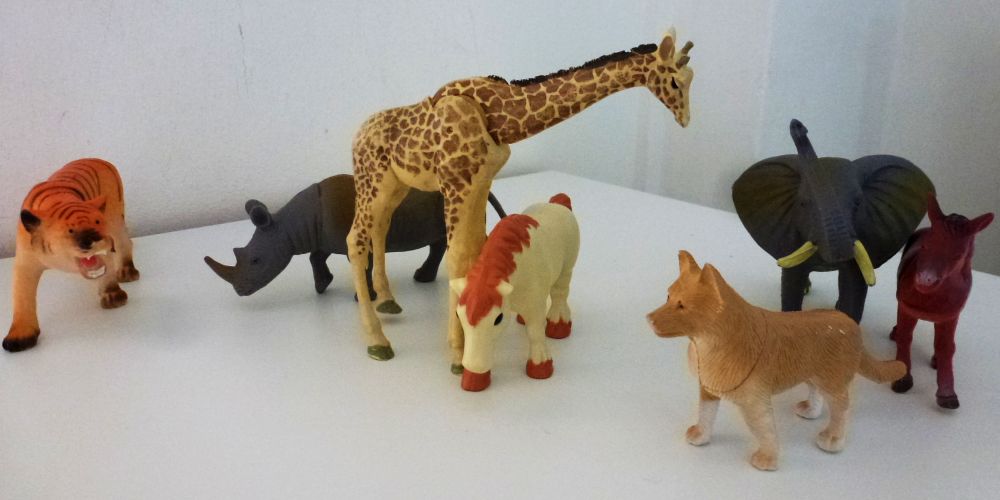If you’re discussing relationships in therapy, it can be useful to use a family sculpt (originally developed by Kantor and Duhl, 1973) to gain a better understanding of the client’s support system and family dynamics.
Sculpts involve arranging figures (people or objects) in a given space, to represent the relationships they have with one another. If you are working with the entire family, then you can ask one person to arrange the others in positions around the room. If you are working with an individual, you can ask them to select objects to represent each family member including themselves.
Objects can include toy animals, chess pieces, cuddly toys or just random objects. When someone selects an object, its helpful to have a conversation about why they chose that item. For example, they might choose a dog if they feel they are loyal or a goat if they feel they are stubborn.
Generally the person picks an item to represent themselves first and places it in the middle of the table. They then select an item for a family member, place it on the table in relation to them and talk about the relationship. They continue this until they have covered all the important people in their life.
Placing someone far away may show that they feel distant from that person. Placing someone in the middle of two other figures might show that they are a mediator. Placing two facing one another might show conflict. There have been occasions when clients have walked out of the room and placed a figure outside of the door, which says a lot about the relationship.
They might also choose an animal to represent their mental health problem (eg depression as a black dog) and place it on the table to show how it affects their relationships. It may be that all the figures are united against the mental health problem or it may be that the mental health difficulty is keeping them isolated from other family members.
When discussing their relationships, its helpful to use circular questioning to invite other narratives and perspecitves; for example, asking ‘what do you think your brother would say about your relationship if he was here?’ or ‘Where would he put the figures?’
You can also ask them how to sculpt how their relationships used to be in the past or how they would like them to look. Try not to assume that everyone wants their family close together. Some people may be happy that a family member is no longer taking an active role in their life.
Steps for a family sculpt using toy animals:
- Explain that you are going to create a representation of their family on the table using toy animals.
- Get them to chose animals for themselves, family, friends and possibly also their mental health problem.
- Ask about each one:
What traits do they share with that animal?
What are their strengths and weaknesses?
What animals does it get on with?
Is it a predator or prey?
How does it defend itself? - Ask them to place themself in the middle of the table and the other animals around them, based on how close they feel to them.
- Ask about how they’ve arranged the animals:
Why have you chosen to put them there and not closer to you?
Is your sister on the edge of the table because you feel distant from her?
Is your mum between you and your dad because she mediates?
Is your brother facing you because he’s listening or arguing? - Include circular questioning about other perspectives:
What animal would your Mum have picked for you?
If your Dad was here, where would he put his animal?
Do you think your sister would also think she was a cat?
How would your brother arrange these?
How close do you think your mum feels to your sister? - Try asking about changes:
How were your family arranged before the anxiety?
How would you like things to be?
What would happen if this family member wasn’t on the table? - It can be useful to end by writing a letter to a family member (which can be therapeutic, whether they give it to the person or not) or making a plan for what things they want to do differently to improve their relationships.
Examples:

Client was a hardworking horse, protected by her Giraffe mother who was always watching over head. Grumpy Rhino Step-Dad doesn’t really deal with the kids much but keeps away the dangerous Tiger Biological Dad. Friend is a loyal dog, always nearby. Two other friends at school who are an elephant and horse.
 Client (little vulnerable chick) is separated by her undisclosed sexuality (white cat) from her mum (chicken). No barriers between her and her friends as they are aware of her sexuality.
Client (little vulnerable chick) is separated by her undisclosed sexuality (white cat) from her mum (chicken). No barriers between her and her friends as they are aware of her sexuality.

Client (baby giraffe) very close to her mum (adult giraffe facing her) but mum’s new partner (big strong elephant) keeps pushing client out of the way. Stubborn friend (goat) is always by her side. Younger brother (cow) is oblivious to the situation.
Some more examples:

I completely agree with what you have written. I hope this post could reach more people as this was truly an interesting post.
Please visit my new youtube channel: https://www.youtube.com/@DrDanielleCrane